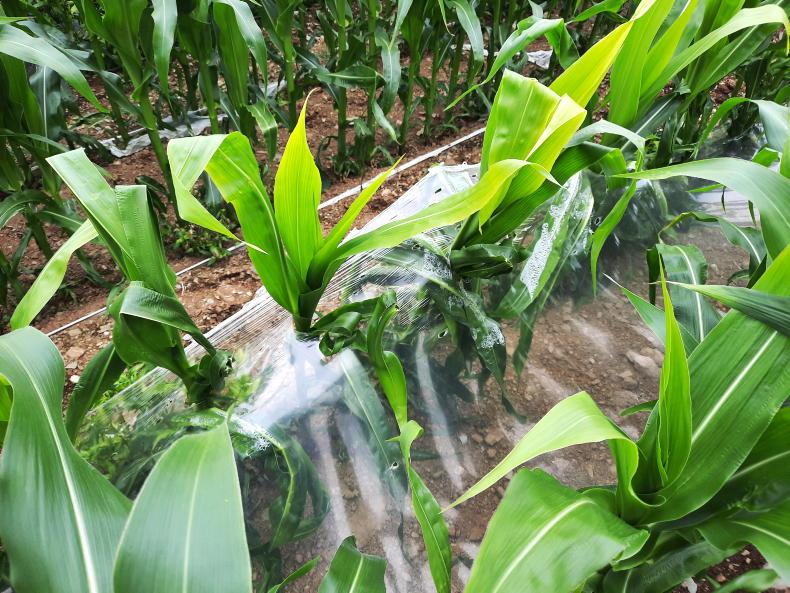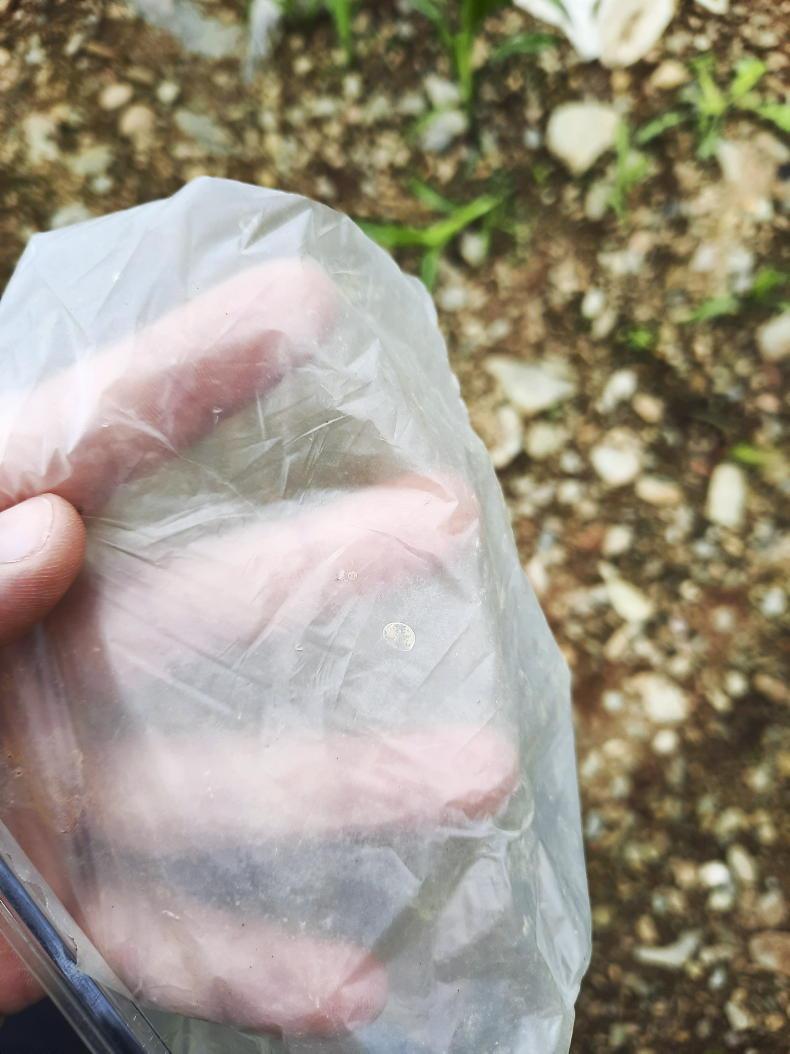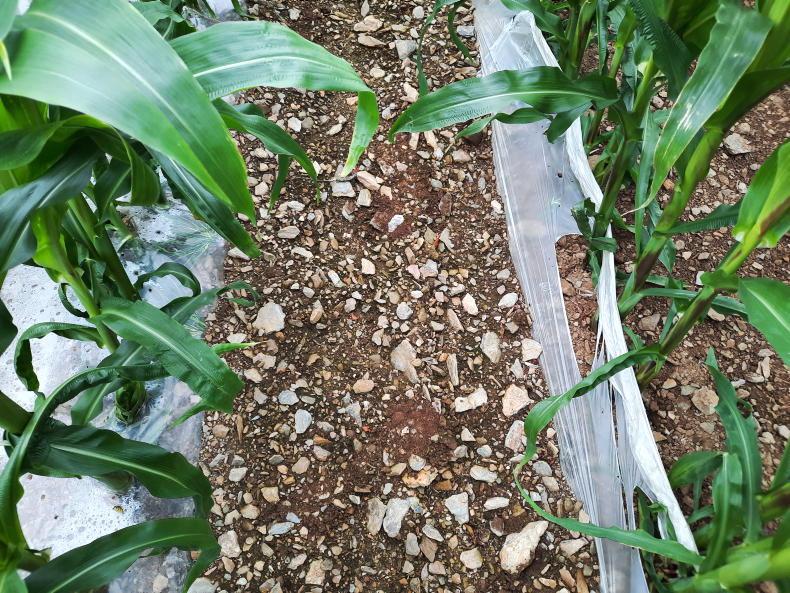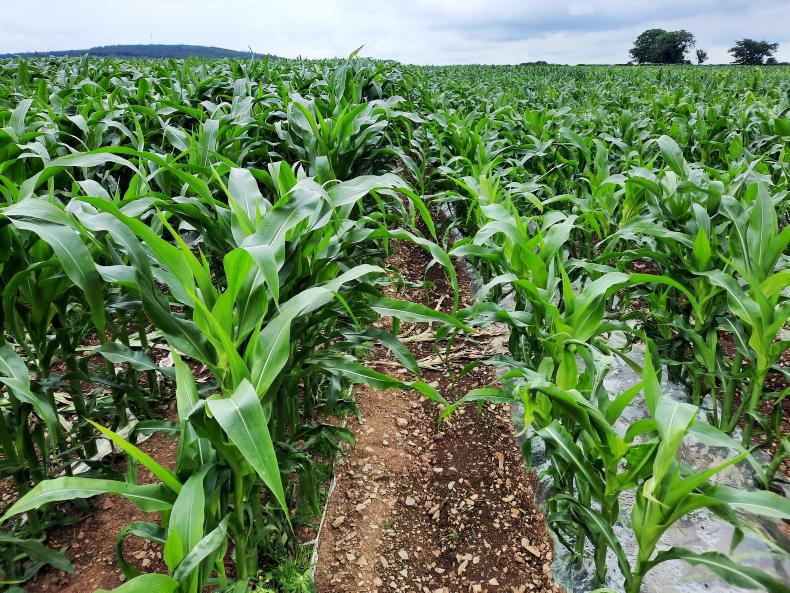For many farmers, the banning of plastic used in maize production came as a shock.
On 3 July, along with chopsticks, cutlery and straws, all oxo-degradable plastic products were banned and this is where maize plastic was hit.
The industry, however, has been preparing for this for some time.
The Irish Farmers Journal travelled to Maizetech, Co Wexford, in early July, to see compostable alternatives to current maize coverings. The crops were impressive and appeared to be much further on in growth and in some cases, under less stress than those under the plastic film.
The compostable film is currently in use by some growers. Maizetech has the product on over 150ac, for farmers looking for a more environmentally-friendly product.
Having investigated many different alternatives, John Foley is confident in the product he now has, but knows many farmers can be slow to change and hopes that the changeover sees the maize area hold strong.

Maize struggling to break through oxo-degradable plastic on 8 July. The compostable film had broken down and disappeared.
When we see chemicals banned, there is usually a use-up period, a time for people to adjust and try the new products.
This has not come. The alternative, of course, will be more expensive, but yield data at the end of the year will show how it affects crops and it still appears to be delivering bang for your buck.
What is compostable film?
Compostable film is a replacement for plastic film used in maize production.

The compostable film breaks down easily.
It is made mainly from plant starch. It is broken down quickly by bugs and microorganisms, whereas the now-banned plastic cover was broken down by UV light and could last for long periods of time in the soil as it does not break down until exposed to light.
The new film is similar to the compostable bags in supermarkets and is used in the very same way as the oxo-degradable plastic. It is simply a different product on the roll.
How is it performing?
Maizetech has trialed many different types of alternative films and has now settled on its alternative, which has been tested since 2017 and has seen all weathers, from drought to cold and wet sowing conditions to frost for the majority of May in 2021.

Oxo-degradable plastic on the left and compostable film on the right.
Looking at the plastic and compostable film in the field, the maize planted under compostable film was at a more advanced growth stage and appeared stress free, while some plants under the oxo-degradable plastic were struggling to break through and appeared yellow.
On the other hand, the compostable film was easy to break and much of it had already disappeared in early July.
Delay planting
One thing that has to happen with this product is farmers have to be prepared to delay planting.
John explained: “From our experience of using this over the years, there is no way we would hand this out to any farmer before 20 April. If they were to plant on 1 April the crop would break through too early and there would be a huge risk of frost damage.
“If you were to put in the compostable film in the last week in April, they would both [compostable and oxo-degradable plastic] be at the same stage of maturity at the end of May. It will do an awful lot more work in a shorter period of time.”

Compostable film on the left and oxo-degradable plastic on the right.
John explained that the new film absorbs moisture and creates a drier climate under the cover. Readers will be familiar with condensation building up underneath the old plastic.
Maize is a tropical crop, so the dry heat under the compostable film appears to be a help to growth. While open crops take all weather and the plant is smaller, crops planted in early April under cover and exposed to frost in May will be further on in growth and more susceptible to damage.
Maize planted in the open
Maize is a tropical crop and needs heat to germinate. This is why the majority of the maize crops grown in Ireland are covered.
Plastic adds to the cost of growing, but also results in higher yields and improved quality in the majority of sites, because many areas of Ireland are not suited to planting maize in the open.
Maize planted in the open generally requires a higher seeding rate, a later sowing date and has lower yield, lower dry matter content and lower starch content.
Adjustment period
At present, farmers are facing into the unknown and despite being confident in the new product, John is worried that there is no adjustment period.
“Farmers need to get their heads around what’s happening. To say to a farmer on 3 July ‘you can’t use this film, you have to use something that’s 50% more expensive’ is difficult. There needs to be a time period for farmers to try out the new product.
“I don’t see a dramatic drop in area, but we will see farmers who are nervous of the new product. There will be more farmers growing maize in the open on drier sites, but those crops won’t do the business every year.”
Maize area in Ireland:
2019 – 16,555ha.2020 – 14,712ha.2021 – 14,428ha (provisional figure).Why is maize important?
Maize is used for animal feed in Ireland and is high in energy, often suited to dairy herds supplying winter milk.
Maize is also a good break crop in tillage rotations and can often allow tillage farmers to import slurry from the livestock farmer they are growing the maize for on to their farm to grow the crop.

For many farmers, the banning of plastic used in maize production came as a shock.
On 3 July, along with chopsticks, cutlery and straws, all oxo-degradable plastic products were banned and this is where maize plastic was hit.
The industry, however, has been preparing for this for some time.
The Irish Farmers Journal travelled to Maizetech, Co Wexford, in early July, to see compostable alternatives to current maize coverings. The crops were impressive and appeared to be much further on in growth and in some cases, under less stress than those under the plastic film.
The compostable film is currently in use by some growers. Maizetech has the product on over 150ac, for farmers looking for a more environmentally-friendly product.
Having investigated many different alternatives, John Foley is confident in the product he now has, but knows many farmers can be slow to change and hopes that the changeover sees the maize area hold strong.

Maize struggling to break through oxo-degradable plastic on 8 July. The compostable film had broken down and disappeared.
When we see chemicals banned, there is usually a use-up period, a time for people to adjust and try the new products.
This has not come. The alternative, of course, will be more expensive, but yield data at the end of the year will show how it affects crops and it still appears to be delivering bang for your buck.
What is compostable film?
Compostable film is a replacement for plastic film used in maize production.

The compostable film breaks down easily.
It is made mainly from plant starch. It is broken down quickly by bugs and microorganisms, whereas the now-banned plastic cover was broken down by UV light and could last for long periods of time in the soil as it does not break down until exposed to light.
The new film is similar to the compostable bags in supermarkets and is used in the very same way as the oxo-degradable plastic. It is simply a different product on the roll.
How is it performing?
Maizetech has trialed many different types of alternative films and has now settled on its alternative, which has been tested since 2017 and has seen all weathers, from drought to cold and wet sowing conditions to frost for the majority of May in 2021.

Oxo-degradable plastic on the left and compostable film on the right.
Looking at the plastic and compostable film in the field, the maize planted under compostable film was at a more advanced growth stage and appeared stress free, while some plants under the oxo-degradable plastic were struggling to break through and appeared yellow.
On the other hand, the compostable film was easy to break and much of it had already disappeared in early July.
Delay planting
One thing that has to happen with this product is farmers have to be prepared to delay planting.
John explained: “From our experience of using this over the years, there is no way we would hand this out to any farmer before 20 April. If they were to plant on 1 April the crop would break through too early and there would be a huge risk of frost damage.
“If you were to put in the compostable film in the last week in April, they would both [compostable and oxo-degradable plastic] be at the same stage of maturity at the end of May. It will do an awful lot more work in a shorter period of time.”

Compostable film on the left and oxo-degradable plastic on the right.
John explained that the new film absorbs moisture and creates a drier climate under the cover. Readers will be familiar with condensation building up underneath the old plastic.
Maize is a tropical crop, so the dry heat under the compostable film appears to be a help to growth. While open crops take all weather and the plant is smaller, crops planted in early April under cover and exposed to frost in May will be further on in growth and more susceptible to damage.
Maize planted in the open
Maize is a tropical crop and needs heat to germinate. This is why the majority of the maize crops grown in Ireland are covered.
Plastic adds to the cost of growing, but also results in higher yields and improved quality in the majority of sites, because many areas of Ireland are not suited to planting maize in the open.
Maize planted in the open generally requires a higher seeding rate, a later sowing date and has lower yield, lower dry matter content and lower starch content.
Adjustment period
At present, farmers are facing into the unknown and despite being confident in the new product, John is worried that there is no adjustment period.
“Farmers need to get their heads around what’s happening. To say to a farmer on 3 July ‘you can’t use this film, you have to use something that’s 50% more expensive’ is difficult. There needs to be a time period for farmers to try out the new product.
“I don’t see a dramatic drop in area, but we will see farmers who are nervous of the new product. There will be more farmers growing maize in the open on drier sites, but those crops won’t do the business every year.”
Maize area in Ireland:
2019 – 16,555ha.2020 – 14,712ha.2021 – 14,428ha (provisional figure).Why is maize important?
Maize is used for animal feed in Ireland and is high in energy, often suited to dairy herds supplying winter milk.
Maize is also a good break crop in tillage rotations and can often allow tillage farmers to import slurry from the livestock farmer they are growing the maize for on to their farm to grow the crop.












 This is a subscriber-only article
This is a subscriber-only article











SHARING OPTIONS: